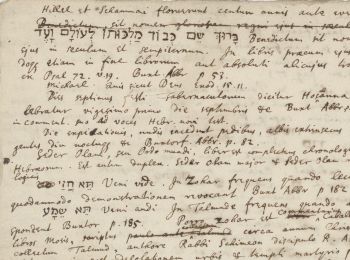A new exhibition will present manuscripts that have not yet been exposed to the public eye and from which it appears that the end of the world according to Newton's calculations is the year 2060

The National Library at the Hebrew University will present a new exhibition of the writings of Sir Isaac Newton, the renowned English scientist of the seventeenth century. The exhibition that will present manuscripts that have not yet been exposed to the public eye will open on June 18, 2007 and close on July 17, 2007.
The exhibits in the exhibition - "Newton's Secrets" - bring the visitor together with hidden aspects of Newton's work and personality, says Prof. Yemima Ben Menachem from the Department of Philosophy at the Hebrew University and the curators of the exhibition. They reveal his research in the field of alchemy and his interest in ancient history and the calculation of the end of the world. Newton, the writings say, invested inexhaustible efforts in deciphering writings that he believed contained encrypted secret knowledge, mainly, holy writings of ancient cultures and historical documents. For example, Newton tried to extract information of scientific value from biblical and Talmudic descriptions of the Tabernacle and the Temple.
The exhibition's treasures provoke a rethinking of the accepted contrasts: religion and science, innovation and tradition, rational and irrational. Among the exhibits you can see a manuscript in which, according to clues from the book of Daniel, Newton calculated the end of days for the year 2060. Many manuscripts relate to the tabernacle and the temple, and alongside them are passages that Newton copied from the Rambam. In another manuscript, we can recognize the familiar Hebrew words from the "Hear Israel" prayer: Blessed be the name of the glory of His kingdom forever and ever. Newton even opposed the idea of the Trinity. He believed that God is one and that Jesus is the Son of God or Messiah and not God himself. Newton did not publicly express his opposition due to fear of sanctions that were imposed at the time for upholding these beliefs. Now this matter emerges from his letters. Also in the exhibition: drawings of devices, various alchemical drawings and early patterns.
Newton's non-scientific writings were sold in 1936 at a Sotheby's auction in London. A significant part of the writings was acquired by two scholars: the British economist John Maynard Keynes, who bequeathed his collection to King's College at the University of Cambridge in England, and the Orientalist Avraham Shalom Yehezkel Yehuda.
Before his death in 1951 Yehuda bequeathed Newton's manuscripts (as well as other manuscripts in his possession) to the State of Israel. The collection arrived at the National Library in 1969 and now it is being presented to the public for the first time.
The curators of the exhibition also include: Prof. Mordechai Feingold from the California Institute of Technology and Prof. Stephen Snowblen from King's College University in Canada.
A virtual version of the exhibition that allows viewing the manuscripts and rare books from this collection has been uploaded to the library's website. Place of the exhibition: The National Library, Edmond Y. Campus Safra Givat Ram, The Hebrew University of Jerusalem. Opening times: Sunday-Thursday 19:00-09:00; Friday 15:00-09:00.
For the first chapter from the biography: Isaac Newton, by James Glick

2 תגובות
Dr. Aibal Leshem Ramati: Isaac Newton and the Temple
I would like to receive the title of the book written by Dr. .... in an interview with Dov Elboim and the topic was Mishkan and Newton